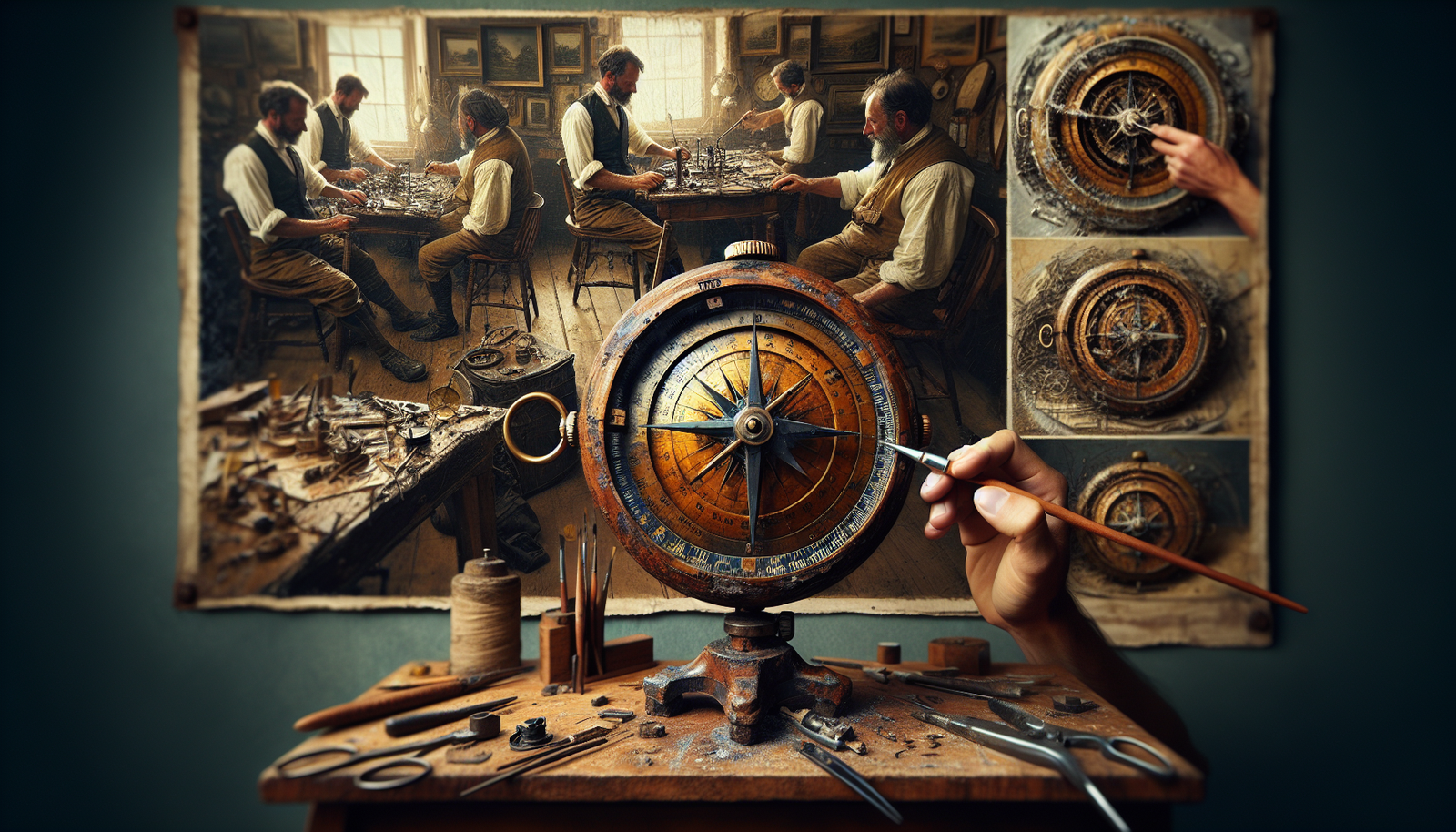Antique Compass Restoration
Have you ever come across an old, worn-out compass and wondered about the stories it holds? Antique compass restoration is a delicate art form that brings these beautifully crafted instruments back to life. This process involves cleaning, repairing, and preserving these historical artifacts, ensuring that they retain their original charm and functionality. By reviving these compasses, experts not only restore their aesthetic appeal but also preserve the rich history and navigation techniques they represent. So, if you’ve ever wanted to explore the past through a timeless instrument, antique compass restoration might just be the intriguing hobby for you.
Antique Compass Restoration

Introduction to Antique Compasses
Antique compasses are fascinating pieces of history that have both practical and aesthetic value. These timeless treasures were once essential tools for explorers, navigators, and adventurers who needed a reliable way to find their way in the world. They come in a variety of designs, from pocket-sized compasses to larger, more intricate models. Restoring an antique compass allows you to bring it back to its former glory and appreciate the craftsmanship and functionality of these magnificent artifacts.
Understanding the Value of Antique Compasses
Antique compasses hold significant historical and sentimental value. They are not just ordinary objects; they are artifacts that have witnessed countless journeys and experiences. Owning and restoring an antique compass allows you to connect with the past and appreciate the craftsmanship and ingenuity of those who came before us. The value of these compasses can also appreciate over time, making them sought-after collectors’ items. Restoring an antique compass not only preserves its historical significance but also enhances its value for future generations.
Common Issues with Antique Compasses
Antique compasses, due to their age and usage, often suffer from various issues that require restoration. The most common problems include rust, tarnish, damage to the casing or glass, dysfunctional or loose hinges, and missing or broken components like needles or sighting wires. These issues can diminish the compass’s functionality and appearance. However, with the right tools, materials, and techniques, these problems can be effectively addressed through a restoration process.
Tools and Materials Needed for Restoration
Restoring an antique compass requires a set of specialized tools and materials to ensure a successful and safe restoration. Some of the essential tools you will need include precision screwdrivers, watchmaker’s tweezers, needle files, a jeweler’s loupe for magnification, a polishing cloth, and a compass needle oscillation device. Additionally, you will need materials such as metal polish, a rust remover, epoxy adhesive, replacement components (if necessary), and a soft cloth for cleaning. Having these tools and materials will make the restoration process much smoother and more efficient.

Cleaning and Polishing the Compass
Before starting any repairs or replacements, it is essential to thoroughly clean and polish the compass. Begin by gently removing any dirt or debris from the exterior using a soft cloth. For more stubborn dirt or tarnish, a mixture of mild soap and warm water can be used. Be careful not to soak the compass; instead, lightly dampen the cloth and clean the surface. Once the compass is clean, use a specialized metal polish to gently remove any oxidation or tarnish, taking care to follow the manufacturer’s instructions. Regular polishing will bring back the compass’s shine and enhance its overall appearance.
Repairing Damaged Components
Antique compasses often have damaged components that require repair. If the compass needle is bent or broken, it can be carefully straightened or replaced using a needle oscillation device. Loose hinges or broken casing can be repaired using epoxy adhesive, ensuring a secure and stable structure. It is important to handle these delicate repairs with care and precision, as improper techniques may further damage the compass. Taking your time and consulting professional advice when needed will help ensure a successful repair.
Replacing Missing or Broken Parts
In some cases, antique compasses may have missing or irreparably broken parts. If this is the case, finding suitable replacement parts is crucial to restoring the compass’s functionality. There are specialized antique compass part suppliers that can provide authentic replacements for various compass components. It is important to carefully research and identify the correct replacement parts specific to your compass model. Once obtained, these parts can be carefully installed using the appropriate tools and techniques.
Refurbishing the Compass Case
The compass case is not only a protective covering for the delicate internal components; it is also an essential part of the compass’s aesthetics. Restoring the case requires careful attention to detail and an understanding of the original design. Begin by removing any scratches or scuffs using a fine-grit sandpaper or polishing cloth. If the case has lost its luster, applying a specialized case polish can help restore its original shine. Additionally, replacing missing or damaged hinges, clasps, or decorative elements can further enhance the case’s appearance and functionality.
Calibrating and Testing the Compass
After the compass has been cleaned, repaired, and refurbished, it is crucial to calibrate and test its accuracy. Start by ensuring the compass is placed on a level surface, away from any magnetic or electronic interference. Use a known reference point, such as true north or a reliable compass, to check the accuracy of the needle. Adjustments can be made using a small screwdriver or adjusting mechanism, depending on the compass’s design. Once calibrated, test the compass in various orientations to ensure accurate readings throughout its full range of motion.
Preserving and Displaying the Restored Compass
Once the restoration process is complete, it is important to preserve and display the restored compass appropriately. To preserve its restored condition, store the compass in a dry, dust-free environment, away from direct sunlight or extreme temperatures. Avoid handling the compass excessively to prevent unnecessary wear and tear. When displaying the compass, consider using a protective display case or stand to showcase its beauty and protect it from accidental damage. Additionally, providing a brief history or description of the compass can help educate and engage others who view the display.
Restoring an antique compass is a rewarding endeavor that allows you to breathe new life into a piece of history. By understanding the value, addressing common issues, and using the right tools and materials, you can successfully restore an antique compass to its former glory. Whether you choose to display it as a cherished heirloom or add it to your collection, the restored compass will continue to tell stories of exploration and navigation for generations to come.




